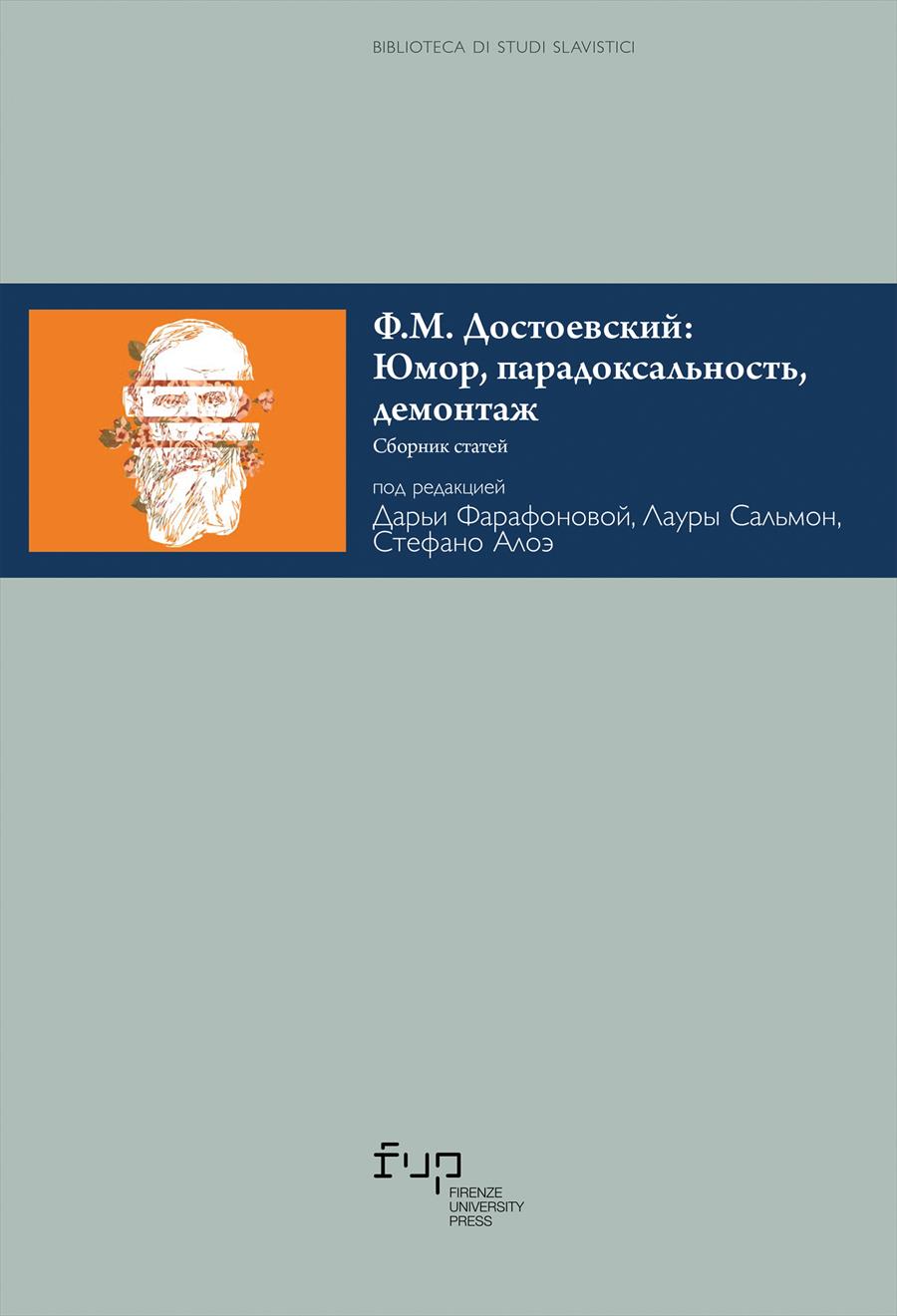- Ф.М. Достоевский: Юмор, парадоксальность, демонтаж
- Edited by Dar'ja Farafonova, Laura Salmon, Stefano Aloe
От молчания-оружия к молчанию-диалогу (и обратно?). Парадоксальный путь Раскольникова в Преступлении и наказании
- Raffaella Vassena
- © 2023 Author(s) |
- CC BY 4.0
- DOI: 10.36253/979-12-215-0122-3.13
From Silence-Weapon to Silence-Dialogue (and Back?). Raskol’nikov’s Paradoxical Path in Crime and Punishment. The article explores the phenomenon of silence in Crime and Punishment as an expression of the reverse logic of Dostoevsky’s world. Silence in Dostoevsky escapes any attempt at a univocal interpretation, as the use of molchanie and tishina in his novels suggests. It is an emblem of the mistery of human existence because it concerns the character’s oscillation between the closure in himself and the opening to the other, between the need to express himself and the awareness of never being able to do it properly. Two levels of the functioning of silence are taken into account: as a stylistic technique used by Dostoevsky to enhance the dramatic effect of some scenes and convey the subtlest nuances of the character’s mood; and as a metaphor for Raskol’nikov’s dramatic existential journey from self-affirmation to the affirmation of the other’s being.
- Keywords:
- Dostoevsky,
- Crime and Punishment,
- silence,
- drama,
- paradox,
University of Milan, Italy - ORCID: 0000-0003-4849-337X
- Blake, Elizabeth A. 2006. “Sonya, Silent No More: A Response to the Woman Question in Dostoevsky’s Crime and Punishment.” The Slavic and East European Journal 50 (2): 252-71.
- Capaldo, Mario. 2011. “In che lingua tace Gesù davanti al Grande Inquisitore?” In Uomini, opere e idee tra Occidente europeo e mondo slavo. Scritti offerti a Marialuisa Ferrazzi, a cura di Adalgisa Mingati, Danilo Cavaion, Claudia Criveller, 77-94. Trento: Università degli Studi di Trento – Dip. di Studi Letterari, Linguistici e Filologici.
- Grillaert, Nel. 2011. “«Raise the People in Silence»: Traces of Hesychasm in Dostoevsky’s Fictional Saint Zosima.” Dostoevsky Studies 15: 47-88.
- Jens, Benjamin C. 2016. “Silence and Confession in The Brothers Karamazov.” The Russian Review 75 (1): 51-66. DOI: 10.1111/russ.12061
- Jones, Malcolm. 2005. Dostoevsky and the Dynamics of Religious Experience. London: Anthem Press.
- Papadopoulos, Chloe S. 2021. “Speaking Silently and Overnarrating in Fyodor Dostoevsky’s Krotkaia.” Dostoevsky Studies 24: 17-40. DOI: 10.13136/1013-2309/1009
- Skakov, Nariman. 2009. “Dostoevsky’s Christ and Silence at the Margins of the Idiot.” Dostoevsky Studies 13: 121-40.
- Spektor, Alexander. 2013. “From Violence to Silence: Vicissitudes of Reading (in) The Idiot.” Slavic Review 72 (3): 552-72. DOI: 10.5612/slavicreview.72.3.0552
- Steiner, George. 1995. Tolstoj o Dostoevskij. Milano: Garzanti.
- Stuchebrukhov, Olga. 2009. “Hesychastic ideas and the concept of integral knowledge in Crime and Punishment.” Dostoevsky Studies 13: 77-91.
- Арутюнова, Нина Д. 2000. “Феномен молчания.” Язык о языке, под ред. Нины Д. Арутюновой, 417-36. Москва: Языки русской культуры.
- Бахтин, Михаил М. 1979. “Из записей 1970-1971 годов.” В кн. Михаил М. Бахтин, Эстетика словесного творчества, сост. С.Г. Бочаров, примеч. С.С. Аверинцев и С.Г. Бочаров, 336-60, Москва: Искусство.
- Бахтин, Михаил М. 2002. Проблемы поэтики Достоевского. В кн. Михаил М. Бахтин, Собрание сочинений, в 7 тт., т. 6, 7-300; 466-505. Москва: Русские словари. Языки славянских культур.
- Бердяев, Николай А. 1923. Миросозерцание Достоевского. Прага: YMCA Press.
- Иванов, Вячеслав И. 1987. Достоевский. Трагедия – Миф – Мистика. В кн. Вячеслав И. Иванов, Собрание сочинений, в 4 тт., т. 4, 483-588. Брюссель: Foyer Oriental Chrétien.
- Исупов, Константин Г. 2003. “Метафизика общения.” Достоевский и мировая культура, альманах № 19, гл. ред. Карен А. Степанян, 19-40. Санкт-Петербург: Серебряный век.
- Карякин, Юрий Ф. 2009. Достоевский и Апокалипсис. Москва: Фолио.
- Коробова, Марина М. 2014. “Размышления о глаголе молчать в связи со Словарем языка Достоевского.” В кн. Слово Достоевского. Идиостиль и картина мира, под общей ред. Елены А. Осокиной, 302-9. Москва: ЛЕКСРУС.
- Манн, Юрий В. 1988. Поэтика Гоголя. Москва: Художественная литература.
- Мережковский, Дмитрий С. 2000. Л. Толстой и Достоевский. Москва: Наука.
- Топоров, Виктор Н. 1995. “О структуре романа Достоевского в связи с архаическими схемами мифологического мышления.” В кн. Виктор Н. Топоров, Миф. Ритуал. символ. Образ. Исследования в области мифопоэтического. Избранное, 193-258. Москва: Прогресс - Культура.
- Фокин, Павел Е. 2003. “Жест молчания в поэме Ивана Карамазова Великий инквизитор.” Достоевский и мировая культура, альманах № 19, гл. ред. Карен А. Степанян, 59-66. Санкт-Петербург: Серебряный век.
- Эпштейн, Михаил Н. 2006. Слово и молчание: метафизика русской литературы. Москва: Высшая школа.
Chapter Information
Chapter Title
От молчания-оружия к молчанию-диалогу (и обратно?). Парадоксальный путь Раскольникова в Преступлении и наказании
Authors
Raffaella Vassena
Language
English
DOI
10.36253/979-12-215-0122-3.13
Peer Reviewed
Publication Year
2023
Copyright Information
© 2023 Author(s)
Content License
Metadata License
Bibliographic Information
Book Title
Ф.М. Достоевский: Юмор, парадоксальность, демонтаж
Editors
Dar'ja Farafonova, Laura Salmon, Stefano Aloe
Peer Reviewed
Number of Pages
222
Publication Year
2023
Copyright Information
© 2023 Author(s)
Content License
Metadata License
Publisher Name
Firenze University Press
DOI
10.36253/979-12-215-0122-3
ISBN Print
979-12-215-0121-6
eISBN (pdf)
979-12-215-0122-3
eISBN (epub)
979-12-215-0123-0
Series Title
Biblioteca di Studi Slavistici
Series ISSN
2612-7687
Series E-ISSN
2612-7679
